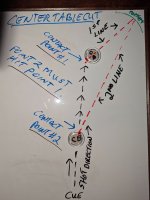I'm
I'm Surprised so many players don't know about this!!! I thot it was common knowledge amongst old heads. My mistake.I believe that he is saying to find the spot on the object ball furthest away from the pocket. Think about it.
Very simple aiming system. Nothing complicated at all. I use it.
First heard it from Allison Fisher.
So simple and uncomplicated.
Try it. Sort of makes sense.
Just try it sometime.
Simple game and we complicate it.
